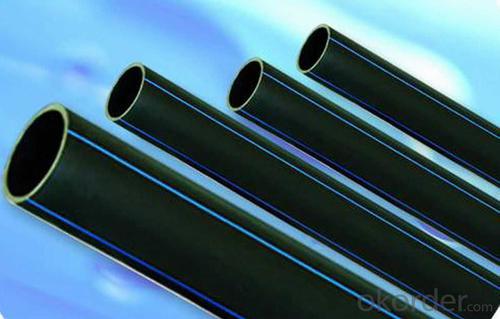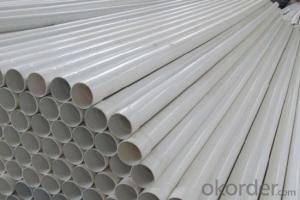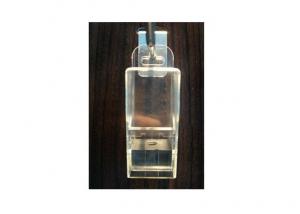HDPE Pipe ISO4427-2000 DN20 Plastic Tubes for Posters
- Loading Port:
- China Main Port
- Payment Terms:
- TT OR LC
- Min Order Qty:
- -
- Supply Capability:
- -
OKorder Service Pledge
OKorder Financial Service
You Might Also Like
Physical properties[edit]
Polyethylene is a thermoplasticpolymer consisting of long hydrocarbon chains. Depending on the crystallinity and molecular weight, a melting point and glass transition may or may not be observable. The temperature at which these occur varies strongly with the type of polyethylene. For common commercial grades of medium- and high-density polyethylene the melting point is typically in the range 120 to 180 °C (248 to 356 °F). The melting point for average, commercial, low-density polyethylene is typically 105 to 115 °C (221 to 239 °F).it is transprant.
Chemical properties[edit]
Most LDPE, MDPE and HDPE grades have excellent chemical resistance, meaning that it is not attacked by strong acids or strong bases. It is also resistant to gentle oxidants and reducing agents. Polyethylene burns slowly with a blue flame having a yellow tip and gives off an odour of paraffin. The material continues burning on removal of the flame source and produces a drip.[3] Crystalline samples do not dissolve at room temperature. Polyethylene (other than cross-linked polyethylene) usually can be dissolved at elevated temperatures in aromatic hydrocarbons such as toluene or xylene, or in chlorinated solvents such as trichloroethane or trichlorobenzene.[4]
GB/T13663-2000:
| PE63管材规格 | |||||
| 公称 外径dn,mm | SDR33 | SDR26 | SDR17.6 | SDR13.6 | SDR11 |
| 公称压力 PN,Mpa | |||||
| 0.32 | 0.4 | 0.6 | 0.8 | 1.0 | |
| 公称 壁厚 | 公称 壁厚 | 公称 壁厚 | 公称 壁厚 | 公称 壁厚 | |
| 16 | 2.3 | ||||
| 20 | 2.3 | 2.3 | |||
| 25 | 2.3 | 2.3 | 2.3 | ||
| 32 | 2.3 | 2.4 | 2.9 | ||
| 40 | 2.3 | 2.3 | 3.0 | 3.7 | |
| 50 | 2.3 | 2.9 | 3.7 | 4.6 | |
| 63 | 2.3 | 2.5 | 3.6 | 4.7 | 5.8 |
| 75 | 2.3 | 2.9 | 4.3 | 5.6 | 6.8 |
| 90 | 2.8 | 3.5 | 5.1 | 6.7 | 8.2 |
| 110 | 3.4 | 4.2 | 6.3 | 8.1 | 10.0 |
| 125 | 3.9 | 4.8 | 7.1 | 9.2 | 11.4 |
| 140 | 4.3 | 5.4 | 8.0 | 10.3 | 12.7 |
| 160 | 4.9 | 6.2 | 9.1 | 11.8 | 14.6 |
| 180 | 5.5 | 6.9 | 10.2 | 13.3 | 16.4 |
| 200 | 6.2 | 7.7 | 11.4 | 14.7 | 18.2 |
| 225 | 6.9 | 8.6 | 12.8 | 16.6 | 20.5 |
| 250 | 7.7 | 9.6 | 14.2 | 18.4 | 22.7 |
| 280 | 8.6 | 10.7 | 15.9 | 20.6 | 25.4 |
| 315 | 9.7 | 12.1 | 17.9 | 23.2 | 28.6 |
| 355 | 10.9 | 13.6 | 20.1 | 26.1 | 32.2 |
| 400 | 12.3 | 15.3 | 22.7 | 29.4 | 36.3 |
| 450 | 13.8 | 17.2 | 25.5 | 33.1 | 40.9 |
| 500 | 15.3 | 19.1 | 28.3 | 36.8 | 45.4 |
| 560 | 17.2 | 21.4 | 31.7 | 41.2 | 50.8 |
| 630 | 19.3 | 24.1 | 35.7 | 46.3 | 57.2 |
- Q: Can plastic tubes be used for packaging creams or lotions?
- Yes, plastic tubes can be used for packaging creams or lotions.
- Q: what is dialysis tubing? how can it be used to demonstrate osmosis?
- Dialysis tubing is actually a semi-permeable membrane when used in water. Experiments illustrating osmosis and pressure gradients across a membrane use dialysis tubing. This tubing usually comes in rolls and when wet, will open up into a cylindrical tube that can be tied off at the ends. The tubing can also be fitted over a thistle tube for such experiments. Dialysis tubing is literally a semi-permeable sheet of plastic. [Like a cell membrane, it can allow certain things in, but not everything.] In a dialysis tubing experiment, one fills the inside of the sheet with a concentrated liquid of some sort and then seals off the open ends of the tube. Then, one places the tube and liquid into another type of liquid and after awhile, the liquid from the outside moves inside the tube. What I did for my first dialysis tubing experiment was filling the inside of the tube with a concentrated starch solution and placed the tubing into a beaker of Lugol's solution diluted with distilled water. After a 1/2 hr, some of the Lugol's and distilled water will have entered the dialysis tubing. One can see that osmosis has happened because the Lugol's in the tube would have turned blue when in contact with the starch. Osmosis caused the diluted/unconcentrated solution of Lugol's and dH2O to go through the semi permeable membrane and into the concentrated solution of starch. Like a cell's membrane, if the outside of the cell is more concentrated, the cell would lose water because the the water will leave the cell and go for the concentrated outside environment. If the inside of the cell was more concentrated than the outside, the outside water will go into the cell through the semipermeable membrane.
- Q: How do plastic tubes compare to metal tubes?
- Plastic tubes are generally lighter, more cost-effective, and resistant to corrosion compared to metal tubes. However, metal tubes offer higher strength, durability, and can withstand higher temperatures and pressures. The choice between plastic and metal tubes depends on the specific application and its requirements.
- Q: Have you ever noticed it becomed increasingly difficult to stop unwanted back flow of paste towards the sealed end of the plastic tube. Unlike the earlier metallic tubes which could be rolled up from the bottom and be self retaining, the plastic tubes cannot be wound up into a permanent situation but always unroll to a flat state. I have ideas for a simple solution involving no external gadgetry to fiddle around with, maybe you have ideas too?? Keep it simple. Thanks
- use a rolling pin to squeez the stuff out...and there is a gadget on the market that looks like 2 fingers, you slip the bottom of the tube between the 2 fingers and just turn up so that the tube rolls around and over the fingers and the paste doesn't backflow..got he idea?..but you can always by toothpast in a pump
- Q: That is similar to the white PVC pipe, but clear. It would be great if the hardware store PVC fittings would fit to it also.
- most hardware stores sell it on the rolls and can help you find the fittings depending on what your wanting to hook it up to. check at a local ace hardware good luck :0)
- Q: Can plastic tubes be used for display stands?
- Yes, plastic tubes can be used for display stands. They are lightweight, durable, and versatile, making them suitable for various display purposes such as holding brochures, posters, or small products. Plastic tubes offer a cost-effective and easy-to-assemble solution for creating attractive displays in retail stores, exhibitions, or trade shows.
- Q: I added a bit too much Oil into the engine, so I decide that I would be able to suck the oil out with some tubing. However part of the plastic tubing fell off into the dipstick hole and it possibly in the oil pan now. I call some mechanic, and ended up having some say that it will damage the engine and some saying that it will not effect the engine. Can someone give me a more in-depth explanation. On how I can remove the plastic tubing? and How is will effect the engine? Should I even drive it?
- That's a hard call, It would be best to remove the oil pan and get the part out, I have found tubes in the oil pan where someone had driven the broken part of a tube that had broken off and then a new dip stick tube installed, Its not to likely it will hurt anything if its plastic, another way is to drain the oil and try and fish it out through the drain plug. Good Luck and GOD Bless.
- Q: What supplies do you gather to remove an NG tube and what is the care for the pt. afterwared?
- There are a couple of different types of NG tubes. One type has a bulb for lack of better words on the end. You can't remove that type. It has to be done by a professional. You can really do some damage if you try. If you haven't been given information on the removal, then your doctor is wanting his/her office to remove it. There are several different reasons for this. It depends on the reason why there is an NG tube.
- Q: Can plastic tubes be used for craft projects like DIY lamps?
- Yes, plastic tubes can be used for craft projects like DIY lamps. They can be easily cut, shaped, and manipulated to create unique lamp designs. Additionally, plastic tubes are lightweight, durable, and come in various sizes and colors, making them a versatile material for crafting.
- Q: I've just started my phlebotomy class and have 8 different colors tubes which are Yellow (Sterile tube), Light Blue, Red,Gold(SST), Light Green(PST), Green,Lavender, and Grey. I'm having trouble understanding what tubes go where.... like I know Red tube is used for Chemistry and Light Blue is used for Coagulation..... The book really isan't that great so I'm kind of confused... Also I've looked on the internet and they mention a pink tube that is used for blood going to the blood bank but there is no pink tube mentioned anywhere in my book. If anyone could take the time to help me out with this I would appreciate it so much and gladly give you the 10 points...... My instructor is great at the hands on portion of actually drawing the blood but lacking very much so in the lecture portion.... so as you can imagine I'm lost! Thanks so much!
- Phlebotomy Tube Colors
Send your message to us
HDPE Pipe ISO4427-2000 DN20 Plastic Tubes for Posters
- Loading Port:
- China Main Port
- Payment Terms:
- TT OR LC
- Min Order Qty:
- -
- Supply Capability:
- -
OKorder Service Pledge
OKorder Financial Service
Similar products
Hot products
Hot Searches
Related keywords



















